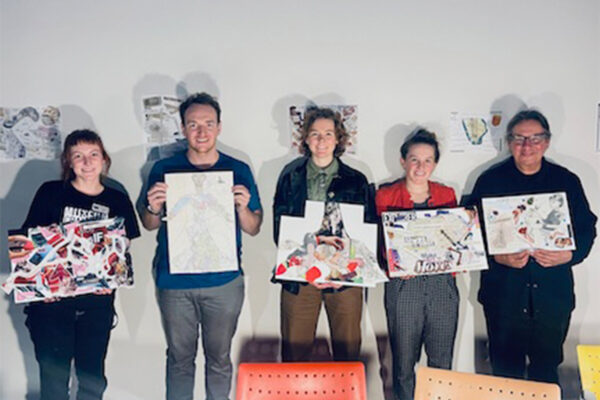
Map Score Compositions with Phillip Greenlief


RECOMMENDED AGE LEVEL
Recommended for ages 4 and up with adult supervision.
PROJECT DESCRIPTION
Internationally acclaimed composer/musician, Phillip Greenlief transcends the boundaries of his field, finding shared language to inspire the maker in all of us.
Interweaving musical score, visual language, and written words, these collaged compositions are guides – intentionally designed to elicit an emotional and creative response on the behalf of their audience. Both MCD’s exhibition Bull.Miletic: Proxistant Vision and Phillip’s Map Score Compositions are rooted in geography and challenge participants to evaluate the thoughts, feelings, and experiences of place and space.
This project invites you to collage a unique composition that inspires the viewer to read, respond, and react.
MATERIALS
Magazine
Map
Stickers
Card Stock Paper
Musical Score Sheet Printable
Glue Stick
Markers
Scissors
DESIGN THINKING
Map score compositions are visual representations of stories that use collage elements and navigation cues to make the abstract tangible and accessible to others.
Think of a song, a memory, or a story.
- How can you express the narrative through collage elements?
- How can you use map elements, music scores, symbols, and words to guide others in the correct chronological interpretation of your map score composition?
INSTRUCTIONS
- What is your story, and who are you telling it to? Decide on an audience and think about the storyline’s themes, characters, and directionality.
- Our map score composition speaks to the local craft community and tells the story of MCD’s MakeArt programs radiating out from the museum to the Bay Area.
- Brainstorm a list of concepts related to your narrative and geographic area.
- Use a graphic organizer to structure and connect brainstormed concepts.
- TIP: Choose a graphic organizer that best suits your narrative. Need a refresher? Learn more in Visme’s 15 Creative Graphic Organizer Types to Visualize Your Content Video.
- Look through magazines and focus on different regions of the map.
- Rip or cut out pictures, words, and geographic areas inspired by the concept brainstorm.
- TIP: Cut out map keys, interesting patterns, and shapes like lines and arrows to help your audience chronologically interpret the map score composition.
- Revisit the graphic organizer. Choose concepts to write onto the music score sheet.
- OPTIONAL: Incorporate musical notation to guide your audience as they read the text score. Check out Tim Hansen’s How to Read Music to learn notation basics.
- Use scissors to cut out text scores.
- Plan out the composition of your map score. Position map/magazine cutouts, stickers, and text score on top of the base paper.
- TIP: You don’t have to use everything. How can you arrange items to create more impact?
- When happy with the layout, use a glue stick to paste each element in place.
- Use markers over the design to add arrows, dotted lines, or commentary that will help the viewer to navigate through the score.
- Share your work with your audience. How do they interpret your map score composition?
RELATED RESOURCES
Map Score Compositions call on our connection to land. Phillip, a Native American artist, uses his work to explore Indigenous Land Rights, telling stories of colonization, land loss, and the ongoing resilience of Indigenous tribes to defend what’s theirs.
The Invasion of America visually demonstrates the colonization of Indigenous land by the US government between 1776 and 2010.
Take a Proxistant Vision approach to learning about Indigenous tribes. Use the maps of Native-Land.Ca to learn about tribes on the local, national, and international level.
CREATIVE PROMPTS FOR MORE
Make and interpret a map score. Complete the project with a friend and interpret each other’s map score composition using a creative process like music, dancing, art, etc.!
Keep telling your story! View each map score composition as a chapter in a book and create a series that chronologically builds off one another.


















